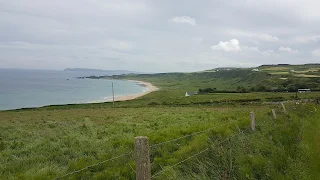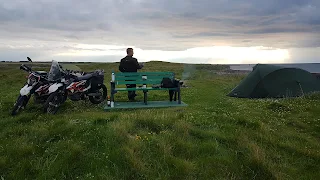I love this part of a trip, the research and route planning morph into the final stages of preparation of kit and vehicle before departure.
My KTM 690 Enduro 2014 hasn't had many changes to be honest. I've changed the air filter style and replaced the battery, chain/sprockets, tyres and tubes etc.
The air filter I've been using for years now is the K&N RU1750. This allows good air flow and fits with the Rade Garage fuel tank I installed. According to the ProScan Reader, there is too much air flow though and my biggest concern is that the paper filter will let through fine sand particles into my intake.
I've spent month's looking for a sand filter for it and have given up. So I started to look at alternatives. The general feedback is to use a foam filter. So I found that the Ram Air foam one fits to the injector body, which has a 62mm circumference. They are used on scooters apparently. I bought this last year for £14.99, this year, a spare is £22. So an increase of £7 in lest than 12 months for the same product.
I've then had to install the air flow sensor into the top of it which is not great. This also creates a problem for fitting any sand filter. So I might have to go old school and find some very fine mesh bag filters to cover the whole thing up. These need to be cleaned daily whilst in the desert and especially after any time in fine sand to protect the engine. That search continues and if push comes to shove, I'll buy some women's fine mesh tights and use them!
Next up, I checked the lithium battery that has been on for about 2 years now. When you press the Test light, it is showing a fair bit of red and as these batteries fail all at once, I decided this wasn't the time to have a dead battery, so ordered a new one. £115.33 later and its fitted.
Next up was to replace the spark plugs and find out why the bike is slow starting. The ProScan identified the coil pack as an issue, so I stripped out the coil packs and the spark plugs and tested them all with a multi meter. The coils are stick coils on KTM's and they had a good reading plus good continuity, so they were fine. I tested the spark plugs and one had no continuity. I changed these and the starting issue was better, but still slow. So next up was to check the micro inline fuel filter next to the battery. Without it, the bike started crisply, with it, it struggled, so £6 later and new one fitted with 2 spares for the trip.
Two other filter pads have been installed into the bike now, one around the main fuel filler cover and one above the air filter in the dead space there. I had some foam in the shed, so this has been cut to size/shape and installed to try to reduce sand dust entering crevices/gaps etc.
Next up was tyres. I had a bit of a scare with tyres as I couldn't find any in the UK in the sizes I wanted. I asked Adventure Spec for their Motoz Deserts and they said they have stopped importing them, (another Brexit casualty). So I researched the options for desert tyres and whilst I found a few, their mileage life was between 2 & 3k miles on the rears and none were in stock.
The Mitas E-09 Dakar was the only ones with feedback of 5k ish miles. I found the fronts, but the rear was only available in 150/70-18's and no 140's were due in before the new year.

Several chats with mates and a bit of a poll online and I bought the pair with 150's from Wheelhouse Tyres in Coleshill, near Birmingham for £211. They fit fine, but the front was a bugger to get on, so I'll add mousse to the tubes in the hopes I don't get a puncture and have to change them in a high heat area. That would ensure some sweating and swearing I'm sure!
Whilst fitting the rear, I checked the corrosion on the rims. I've been meaning to buy new wheels for awhile now, but putting it off because of the £750 cost. It's too late now as there is a six week build wait and I haven't found a second hand one!
The corrosion is increasing, so I cleared the crap off and treated the wheels with a sealant, then spray painted the interior in the hopes that reducing air interaction then they'll last the trip. I'm carrying some metal putty and this will be a last resort thing to get me somewhere. Time will tell I guess. Whatever, this is their last outing.
I've added a sheepskin to the saddle. I've heard so much about their comfort on longer trips and a mate had a skin from one of his sheep going spare. So I cleaned it, shaped it and sent it to DP Leathers at Penrith. He made a saddle for my BSA B40 and did a lovely job. For this he sewed the straps on for me for £5, so now I get to try one for real!
After this lot, I serviced the bike, new filters, new brake fluid, new clutch fluid, DID 520 VX2 chain and sprockets, brake pads all round. Around £200 spent.
I've checked the linkage and wheel bearings. I've got spares of both in stock and will take the wheel bearings with me. The linkage bearings, I'll save for now and change when I get back. There is no play in them at the moment, so its a bit of a gamble as they've been in for awhile now and you need a press to get them out/in.
The wheel bearings were changed about 1000 miles ago, so should be good for this trip, but as they are easy to change, I'll carry spares.
Head bearings appear to last for years on these bikes. But when I get back they'll be due a strip out and replacements installed as they will have done about 50+k miles by then.
One thing I've just been reading is about marine grease and how good its life span is. Desert stuff is different to a lot of travel in that sand gets into any grease and turns it into a grinding paste, so you need some grease to reduce wear and heat, but not so much that sand clogs it up and prematurely wears parts. So it's going to be a bit of a balance between cleaning/checking and riding time to preserve lifespans of parts.
Marine grease is a purchase for another time as I've left it too late now, but I like what I'm reading about it, so I may change from lithium to marine as a standard on all bearings.
That's it again for now. Next post will be on the road... Have a great festive season everyone.






.png)
.png)
.png)
.png)













































